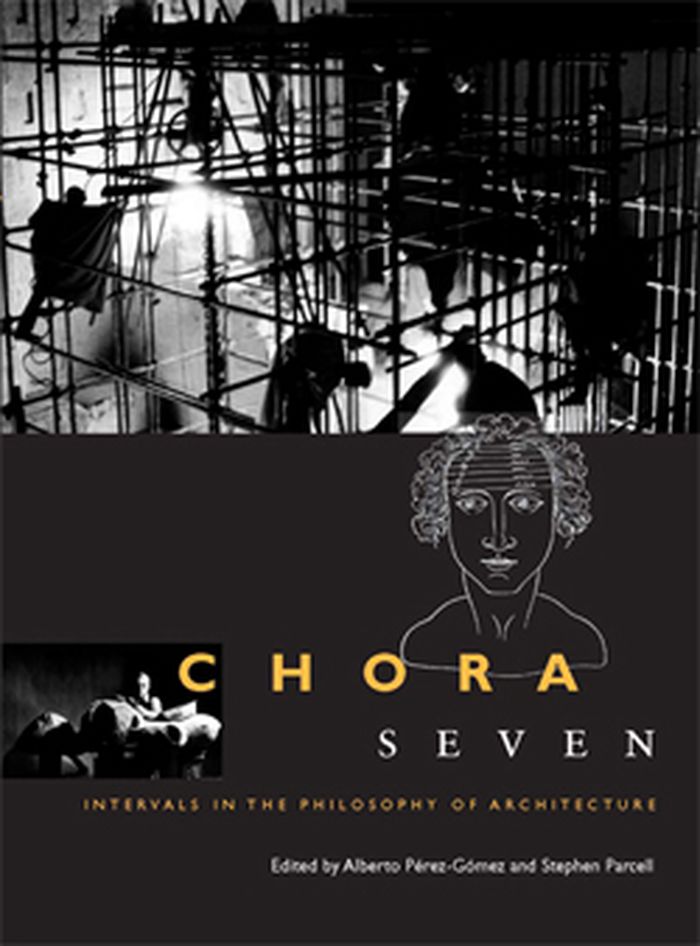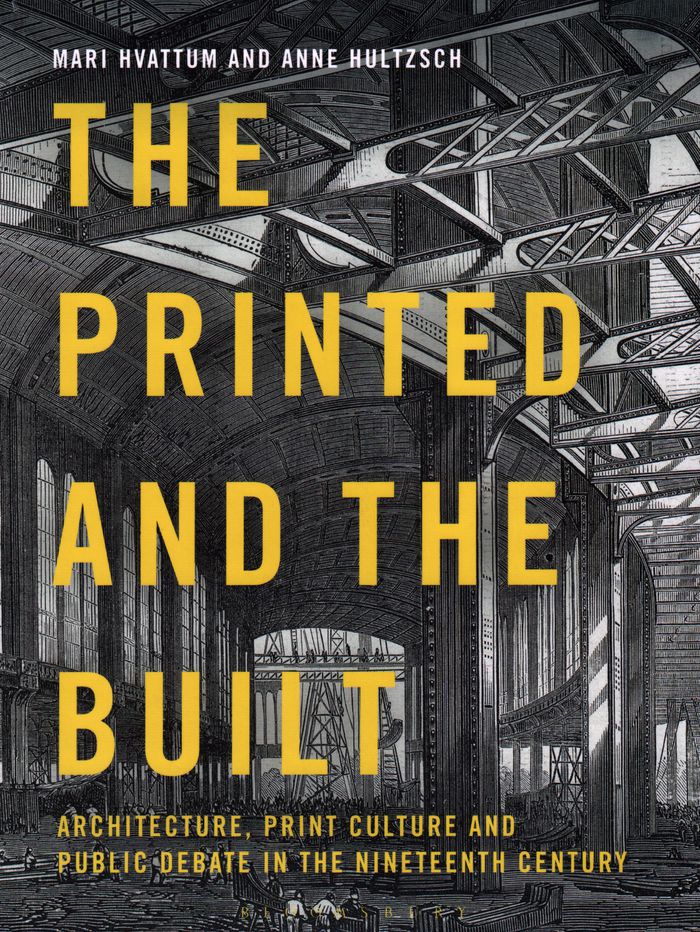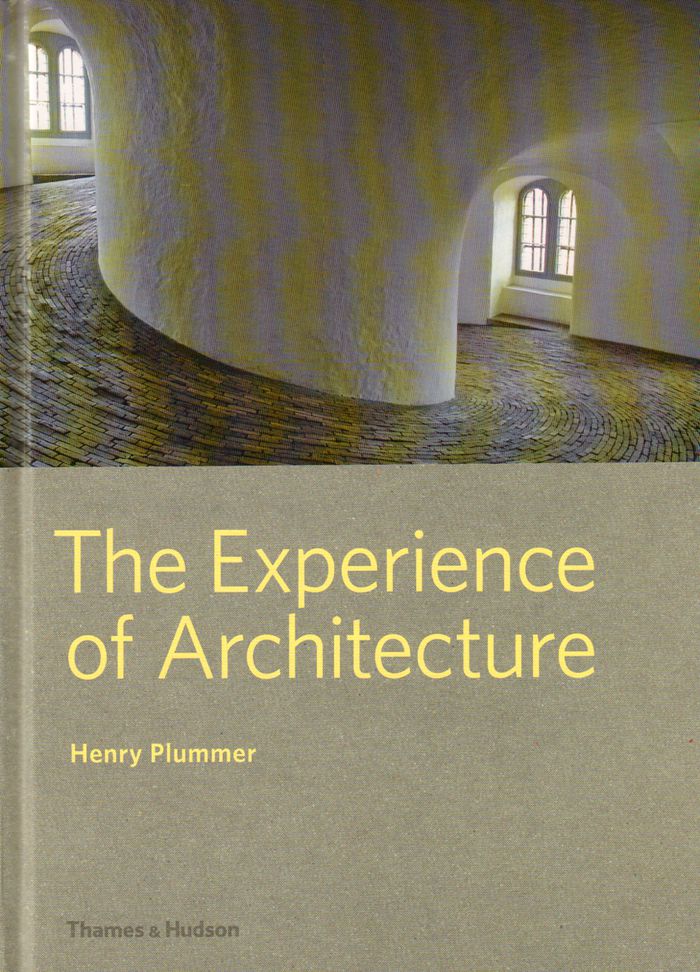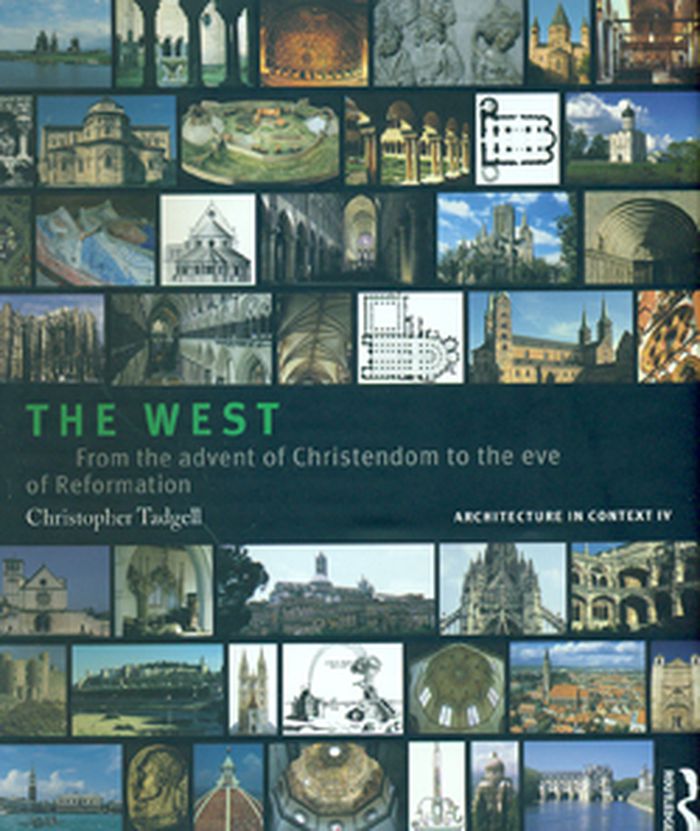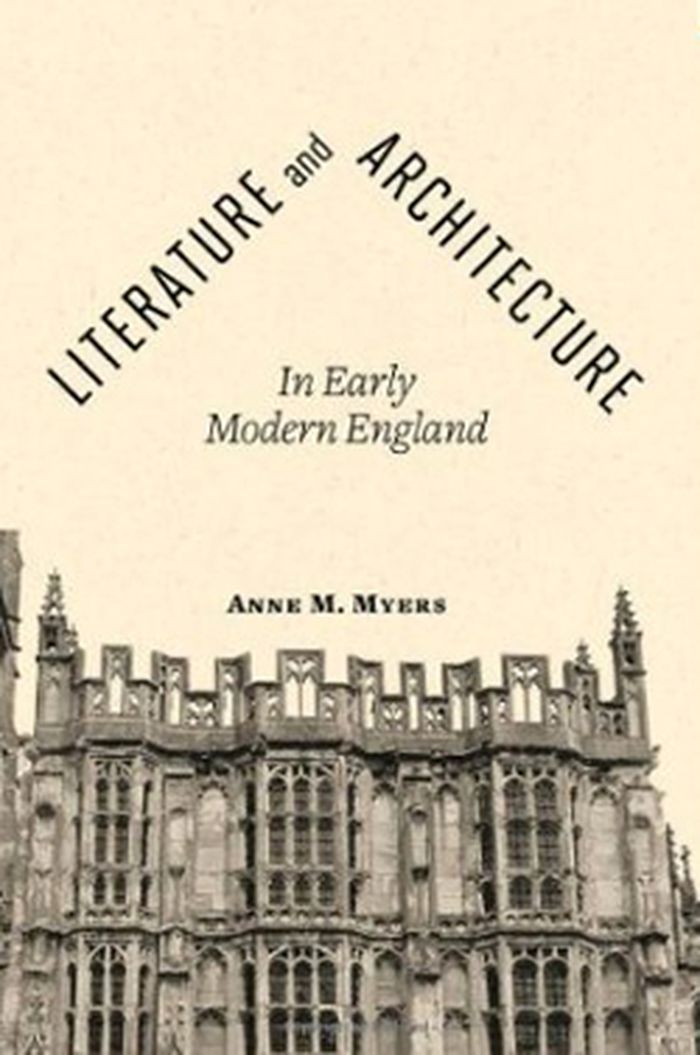$37.95
(available to order)
Summary:
Chora 7, the final volume in the Chora series, includes fifteen essays on architectural topics from around the world (France, Greece, Iran, Italy, Korea, and the United States) and from diverse cultures (antiquity, Renaissance Italy, early modern France, and the past hundred years). Thematically, they bring original approaches to human experience, theatre, architectural(...)
Architectural Theory
February 2016
Chora 7: intervals in the philosophy of architecture
Actions:
Price:
$37.95
(available to order)
Summary:
Chora 7, the final volume in the Chora series, includes fifteen essays on architectural topics from around the world (France, Greece, Iran, Italy, Korea, and the United States) and from diverse cultures (antiquity, Renaissance Italy, early modern France, and the past hundred years). Thematically, they bring original approaches to human experience, theatre, architectural creation, and historical origins. Readers will also gain insights into theoretical and practical work by architects and artists such as Leon Battista Alberti, Peter Brook, Douglas Darden, Filarete, Andy Goldsworthy, Anselm Kiefer, Frederick Kiesler, Claude-Nicolas Ledoux, and Peter Zumthor.
Architectural Theory
books
$68.95
(available to order)
Summary:
This collection contains studies written by art historian James Ackerman over the past decade. Whereas Ackerman’s earlier work assumed a development of the arts as they responded to social, economic, political, and cultural change, his recent work reflects the poststructural critique of the presumption of progress that characterized Renaissance and modernist history and(...)
Architectural Theory
November 2001, Cambridge, Mass.
Origins, imitation, conventions : representation in the visual arts
Actions:
Price:
$68.95
(available to order)
Summary:
This collection contains studies written by art historian James Ackerman over the past decade. Whereas Ackerman’s earlier work assumed a development of the arts as they responded to social, economic, political, and cultural change, his recent work reflects the poststructural critique of the presumption of progress that characterized Renaissance and modernist history and criticism. In this book he explores the tension between the authority of the past--which may act not only as a restraint but as a challenge and stimulus--and the potentially liberating gift of invention. He examines the ways in which artists and writers on art have related to ancestors and to established modes of representation, as well as to contemporary experiences. The "origins" studied here include the earliest art history and criticism; the beginnings of architectural drawing in the Middle Ages and Renaissance; Leonardo Da Vinci’s sketches for churches, the first in the Renaissance to propose supporting domes on sculpted walls and piers; and the first architectural photographs. "Imitation" refers to artistic achievements that in part depended on the imitation of forms established in practices outside the fine arts, such as ancient Roman rhetoric and print media. "Conventions," like language, facilitate communication between the artist and viewer, but are both more universal (understood across cultures) and more fixed (resisting variation that might diminish their clarity). The three categories are closely linked throughout the book, as most acts of representation partake to some degree of all three.
books
November 2001, Cambridge, Mass.
Architectural Theory
books
$52.50
(available to order)
Summary:
In "The Building in the Text", Roy Eriksen shows that Renaissance writers conceived of their texts in accordance with architectural principles. His approach opens the way to wide-ranging discussions of the structure and meaning of a variety of literary texts and also provides new insights into the famed architectural ekphrases of Alberti and Vasari. Analyzing such(...)
The building in the text : Alberti to Shakespeare and Milton
Actions:
Price:
$52.50
(available to order)
Summary:
In "The Building in the Text", Roy Eriksen shows that Renaissance writers conceived of their texts in accordance with architectural principles. His approach opens the way to wide-ranging discussions of the structure and meaning of a variety of literary texts and also provides new insights into the famed architectural ekphrases of Alberti and Vasari. Analyzing such words as "plot," "topos," "fabrica," and "stanza," Eriksen discloses the fundamental spatial symmetries and complexities in the writings of Ariosto, Shakespeare, and Milton, among other major figures. Ultimately, his book uncovers and clarifies a tradition of literary architecture that is rooted in antiquity and based on correspondences regarded as ordering principles of the cosmos.
books
January 1900, University Park
Architectural Theory
The printed and the built: architecture, print culture and public debate in the nineteenth century
$49.95
(available to order)
Summary:
This publication explores the intricate relationship between architecture and printed media in the fast-changing nineteenth century. Publication history is a rapidly expanding scholarly field which has profoundly influenced architectural history in recent years. Yet, while groundbreaking work has been done on architecture and printing in the Renaissance, the(...)
The printed and the built: architecture, print culture and public debate in the nineteenth century
Actions:
Price:
$49.95
(available to order)
Summary:
This publication explores the intricate relationship between architecture and printed media in the fast-changing nineteenth century. Publication history is a rapidly expanding scholarly field which has profoundly influenced architectural history in recent years. Yet, while groundbreaking work has been done on architecture and printing in the Renaissance, the Enlightenment, and the twentieth century, the nineteenth century has received little attention. This is the omission that 'The Printed and the Built' seeks to address, thus filling a significant gap in the understanding of architecture's cultural history.
Architectural Theory
$54.00
(available in store)
Summary:
In ''Vitruvius: Writing the body of architecture,'' Indra Kagis McEwen argued that Vitruvius's first-century BCE treatise ''De architectura'' was informed by imperial ideology, giving architecture a role in the imperial Roman project of world rule. In her sequel, ''All the King's Horses,'' McEwen focuses on the early Renaissance reception of Vitruvius's thought beginning(...)
All the king's horses: Vitruvius in an age of princes
Actions:
Price:
$54.00
(available in store)
Summary:
In ''Vitruvius: Writing the body of architecture,'' Indra Kagis McEwen argued that Vitruvius's first-century BCE treatise ''De architectura'' was informed by imperial ideology, giving architecture a role in the imperial Roman project of world rule. In her sequel, ''All the King's Horses,'' McEwen focuses on the early Renaissance reception of Vitruvius's thought beginning with Petrarch—a political reception preoccupied with legitimating existing power structures. During this ''age of princes'' various signori took over Italian towns and cities, displacing independent communes and their avowed ideal of the common good. Architects, taking up Vitruvius's mantle, designed buildings and other structures for these princes with the intent of celebrating and making their power manifest. Through meticulous descriptions of the work of architects and artists from Alberti to Leonardo, McEwen explains how architecture became an instrument of control in the early Italian Renaissance. She shows how architectural magnificence supported claims to power, a phenomenon best displayed in one of the era's most prominent monumental themes: the equestrian statue of a prince, in which the horse became an emanation of the will of the rider, its strength the expression of his strength.
Architectural Theory
$20.00
(available to order)
Summary:
Interior architecture today operates at the intersection between physical and mediated spaces, such as those of mass communications, digital platforms or visual arts. Considering any form of representation as potentially architectural, from writing to photography, drawing to cinema, Javier Fernández Contreras traces the origins of this process of hybridisation between(...)
Manifestes 1: Manifesto of interiors, thinking in the expanded media
Actions:
Price:
$20.00
(available to order)
Summary:
Interior architecture today operates at the intersection between physical and mediated spaces, such as those of mass communications, digital platforms or visual arts. Considering any form of representation as potentially architectural, from writing to photography, drawing to cinema, Javier Fernández Contreras traces the origins of this process of hybridisation between space and media back to the Renaissance and addresses the role of interiors as an experimental laboratory of late modernity. Combining historic scholarship with bold hypotheses, his essay explores contemporary interiors as platforms of ‘expanded media’, examining their belonging to different places and temporalities, whether physical or virtual, close or distant, ultimately reasserting the role of interior architecture in the construction of contemporaneity.
Architectural Theory
$66.00
(available to order)
Summary:
How does the experience of turning a door handle, opening a door from one space into another, affect us? It is no wonder that the door, one of the most elemental architectural forms, has such metaphorical richness. But even on a purely physical human level, the cold touch of a brass handle or the swish of a sliding screen gives rise to an emotional reaction, sometimes(...)
The experience of architecture
Actions:
Price:
$66.00
(available to order)
Summary:
How does the experience of turning a door handle, opening a door from one space into another, affect us? It is no wonder that the door, one of the most elemental architectural forms, has such metaphorical richness. But even on a purely physical human level, the cold touch of a brass handle or the swish of a sliding screen gives rise to an emotional reaction, sometimes modest, occasionally profound. This book aims to understand how these everyday acts are influenced by architectural form, a concept that is vital for all architects to grasp. It considers how specifically built elements and volumes, taken from a wide array of buildings and settings around the world, can affect our powers of decision. From hand-carved stairs in Greek villages to free-floating catwalks, from the elegant processional steps of Renaissance Italy to Frank Lloyd Wright’s masterly manipulation of form, all provide very different experiences of stepping from one level to the next, and all affect our experience of that space.
Architectural Theory
$119.95
(available in store)
Summary:
Christopher Tadgell covers the major architectural traditions of the Middle Ages, from the Romanesque architecture of the 9th and 10th centuries, built on the legacy of ancient Rome and including elements from Carolingian, Ottonian, Byzantine and northern European traditions, through to the evolution of the Gothic which heralded new, structurally daring architecture. The(...)
The West: from the advent of Christendom to the eve of Reformation
Actions:
Price:
$119.95
(available in store)
Summary:
Christopher Tadgell covers the major architectural traditions of the Middle Ages, from the Romanesque architecture of the 9th and 10th centuries, built on the legacy of ancient Rome and including elements from Carolingian, Ottonian, Byzantine and northern European traditions, through to the evolution of the Gothic which heralded new, structurally daring architecture. The book ends with the Italian rediscovery of Classical ideas and ideals and the emergence of the great Renaissance theorists and architects, including Brunelleschi, Alberti, and Bramante. As well as the palazzos, villas and churches of Renaissance Italy, this period saw the building of great chateaux in France, palaces in Germany and the golden-domed cathedrals of Russia.
books
$34.95
(available to order)
Summary:
In this second volume in the Chora series, contributing authors take an interdisciplinary approach to architecture and other cultural concerns, challenging readers to consider alternatives to conventional aesthetic and technological reductions. Karsten Harris provides a new and long-overdue reading of Martin Heidegger's well-known(...)
Architectural Theory
September 1996, Montréal
Chora 2 : intervals in the philosophy of architecture
Actions:
Price:
$34.95
(available to order)
Summary:
In this second volume in the Chora series, contributing authors take an interdisciplinary approach to architecture and other cultural concerns, challenging readers to consider alternatives to conventional aesthetic and technological reductions. Karsten Harris provides a new and long-overdue reading of Martin Heidegger's well-known essay "Building Dwelling Thinking." Donald Kunze and Stephen Parcell consider possibilities of meaningful architectural space for a visual culture, continuing themes they addressed in Chora 1. Further reflections on the spaces of literature, cinema, and architecture include an interview with French writer and film maker Alain Robbe-Grillet and articles by Dagmar Motycka Weston on the surrealist city, Tracey Eve Winton on the museum as a paradigmatic modern building, and Terrance Galvin on spiritual space in the works of Jean Cocteau. Jean-Pierre Chupin and Bram Ratner explore historical themes in their essays on French Renaissance architect Philibert de l'Orme and the Jewish myth of the Golem. Gregory Caicco addresses ethical questions in his essay on the Greek agora and the death of Socrates, as does Lily Chi in her meditation on the critical issue of use in architectural works. A concern with architectural representation and generative strategies for the making of architecture is present throughout, especially in the essay by Joanna Merwood on the provocative House by British artist Rachel Whiteread.
books
September 1996, Montréal
Architectural Theory
$65.95
(available to order)
Summary:
Buildings tell stories. Castles, country homes, churches, and monasteries are "documents" of the people who built them, owned them, lived and died in them, inherited and saved or destroyed them, and recorded their histories. Literature and Architecture in Early Modern England examines the relationship between sixteenth and seventeenth-century architectural and literary(...)
Literature and architecture in early Modern England
Actions:
Price:
$65.95
(available to order)
Summary:
Buildings tell stories. Castles, country homes, churches, and monasteries are "documents" of the people who built them, owned them, lived and died in them, inherited and saved or destroyed them, and recorded their histories. Literature and Architecture in Early Modern England examines the relationship between sixteenth and seventeenth-century architectural and literary works. By becoming more sensitive to the narrative functions of architecture, Anne M. Myers argues, we begin to understand how a range of writers viewed and made use of the material built environment that surrounded the production of early modern texts in England. Scholars have long found themselves in the position of excusing or explaining England's failure to achieve the equivalent of the Italian Renaissance in the visual arts. Myers proposes that architecture inspired an unusual amount of historiographic and literary production, including poetry, drama, architectural treatises, and diaries. Works by William Camden, Henry Wotton, Ben Jonson, Andrew Marvell, George Herbert, Anne Clifford, and John Evelyn, when considered as a group, are texts that overturn the engrained critical notion that a Protestant fear of idolatry sentenced the visual arts and architecture in England to a state of suspicion and neglect.
Architectural Theory
